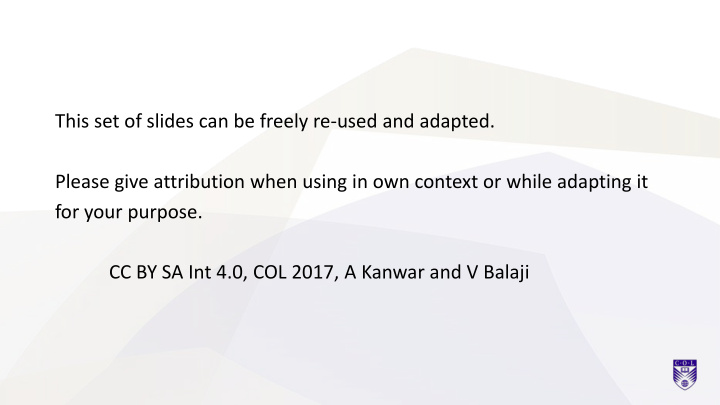



This set of slides can be freely re-used and adapted. Please give attribution when using in own context or while adapting it for your purpose. CC BY SA Int 4.0, COL 2017, A Kanwar and V Balaji
Professor Asha Kanwar, President & CEO Dr. Venkataraman Balaji, Director, Technology and Knowledge Management E-Learn 2017 | Vancouver, Canada | 17 October 2017
The Commonwealth Comprises 52 nations around the world
Commonwealth Heads of Government Meeting Vancouver, 1987
To help Commonwealth governments and institutions use various technologies to improve access to learning in support of development
Context
The Youth ‘Bulge’: 1.2 billion 15-29 Of the 2.2 billion population of the Commonwealth, 60% under the age of 30 Source: The Commonwealth Youth Programme, last accessed on October 12, 2017
Gross Enrolment Ratio 2015 by Region and Level of Education 120 100 80 Secondary 60 Tertiary 40 20 Source: UNESCO Institute for Statistics, 0 Last accessed on October 12, 2017 Developed Developing
MOOCs can be an ally in Open Learning • Provide access to quality learning at low costs. • Build capacity at scale. • Improve learning outcomes, through the use of alternative pedagogical approaches. • Be integrated within national quality assurance frameworks.
MOOC as a Tech Suite…. assessment online event/ media scalability techniques conferencing technology online management
Diversification in MOOCs • No longer limited to credit orientation • Not limited to Higher Education sector
Direct Use of a MOOC Service
Adaptation of Tech XuetangX has Eight Million learners (Sep 2017)
Re-engineering the Tech Suite in MOOC MOOC portal of Ministry of HRD, India (built by Microsoft) For-profits in China, such as 163.com
Why is re-engineering necessary for MOOC4D in Open Education • Reaching out to Faculty with no exposure to TEL • Learners not comfortable with peer-grading and online socialising paradigms in industry-grade MOOCs • Strongly felt need for mentoring in the course space • Video streaming demands bandwidth • implies reasonable or high costs to learners
COL’s MOOC4Dev • Adaptation • Re-engineering and innovation
COL and Indian Institute of Technology Kanpur partnership • MooKIT platform • Scalable to tens of thousands at low cost • Uses publicly accessible video streaming services (such as YouTube) • Content is open (OER) • Audio track of video accessible on a phone • Scripts of talks and slides available (as PDF) • Integrates Social Media into the course discussion space
COL’s MOOC4D: 3 Overview MOOCs 112 18 using just MOOCs on topics basic cell related to Human phones as and Sustainable access countries Development devices 20,000 learners
Platform used for capture of mooKIT Platform analytic ic Deployment data covers ~112,000 more offerings by partners learners in past 30 months
• Videos and text used • Material in video format was couriered on DVDs and memory cards to Sierra Leone and Zambia • The groups completed online assignments and examination; some eligible for certification
Using ICTs to Enrich Teaching and Learning • Collaboration with African Virtual University (AVU) – 2015 • 1,692 registered • Use of video clips, graphics and games Kenya, South Africa, India, United States, Nigeria, Uganda, Trinidad & Tobago, Jamaica, Pakistan, Tanzania
“ …..presenters w ere am azed at the contributions and cross cultural exchanges that happened on Social Media” . Ian Thom son, Course Manager
Platform support
MOOCs for Agriculture • Online learning • Food and Ag sector underserved • A consortium conceptualised by COL, anchored at IIT-Kanpur 25
Important to allow content access in multiple formats
Certificate is not the main source of motivation
Methods of Access (Data from a MOOC, 10 October 2017)
An “Off-lined” MOOC?
Audio-only MOOC for Semi-skilled Gardeners
Audio-only MOOC Correlation between clips listened to and completion rates
Reaching the Bottom Billion • Content should be designed for delivery in low bandwidth • Be able to deliver on a basic phone • Social media integration is a must • Online peer-to-peer interactions must be supplemented with blended approaches • Content should be open (i.e. OER)
Quality
Guidelines for Quality COL Guidelines for MOOCs • Purpose decides quality indicators • Context critical • Accreditation agencies looking for credit equivalence
Guidelines for QAA of MOOCs Process • Platform and Provider • Completion • Credits and Credentials • Satisfaction • Learning Process • Institutions, Instructors • Learners • Engagement and • Instructional Design Participation • Resources Presage Product
Malaysian MOOC Credit Transfer 37 Source: Prof. Dato’ Dr. Mohamed Amin Embi (UKM)
One s e size d does n es not f fit a all Issues for Quality • Student verification and academic integrity • Peer assessment needs to be accepted • Delinking of the institutions which teach and the institutions which offer credential
Implications for Policy
National Policy • View MOOC as a new, interactive broadcast medium • Develop credible QA and Credentialing framework • Focus on Higher Education as well as advanced skills development/in-service training • Develop and nurture a capable and robust infrastructure • Manage costs: adopt OER policies
Rise of the Messaging Paradigm Data from BI Intelligence, Sep 2016
Mainstreaming of MOOCs in developing countries national systems Integration of two technologies: Use of Blockchains for preserving Messaging space integrity of learner for interactions records
Finally, for developing countries • New model of MOOCs required, one that reaches the unreached • MOOCs will supplement rather than replace traditional institutions • Excellent platform for skilling at scale and speed
MOOCs A tool for achieving SDG 4
Thank You col.org
Recommend
More recommend